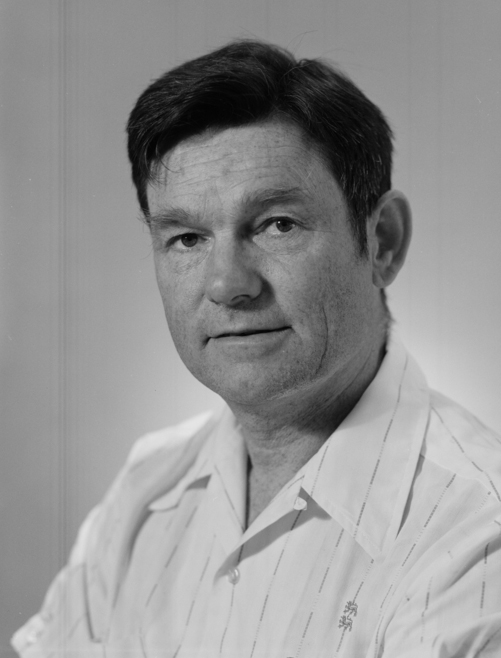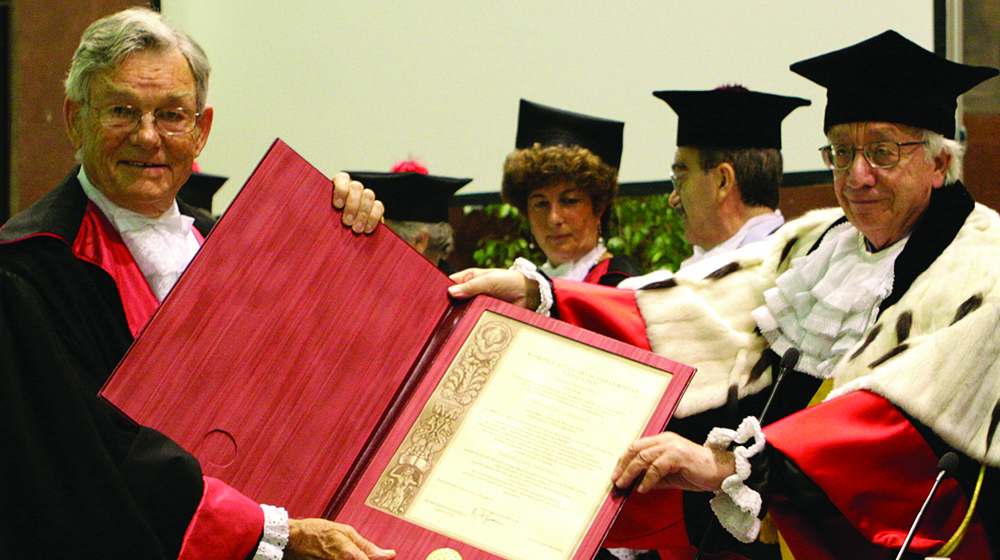Biological Sciences Profile on Dan Lindsley
Dan Lindsley was on his one-year sojourn in Rome when he received a note inviting him to apply for an open professorial position in the Department of Biology at the University of California in San Diego. At that time he was working at the Oak Ridge National Laboratory and had amassed considerable expertise in the radiation-caused mutations in drosophila and X-ray methods of genomic research. He came to UCSD to give his talk and was really impressed by the place and the people. He was excited to find out that his scientific interests were closely aligned with those of Herbert Stern who, at that time, was the Chair of the Department. Besides, both he and his wife were California natives and the idea of moving to beautiful San Diego was truly appealing. Dan joined the young UCSD Department of Biology in 1967 and moved into his lab on the second floor of Bonner Hall. His neighbors were Tom Roth, Herb Stern and Mike Soule. The Department already had about a dozen faculty headed by Herb Stern, who had just taken over from Clifford Grobstein, who moved to the School of Medicine.

Lindsley joined UCSD in 1967.
The next year, his seminal book Genetic Variations (1968), written together with Ed Grell, was published. Dan describes it as the dictionary of mutations and chromosome aberrations in Drosophila melanogaster and a continuation of the work started by Calvin Bridges and Katherine Brehmer (their book The Mutants of Drosophila Melanogaster was published in 1944). The Red Book, as it became widely known among geneticists, was the result of five years of uninterrupted and tireless work and quickly proved to be an invaluable and important resource regularly used by researchers all over the world. It took another 10 years to catch up with an ever increasing volume of research data and revise the book in collaboration with Georgianna Zimm for its 1992 update The Genome of Drosophila Melanogaster. Remarkably, even before publishing their revision, Dan and his co-author shared their manuscript with the start-up online FlyBase, thus building the foundation for what has since become the primary source of the state-of-the-art information for generations of geneticists and molecular biologists.
Thinking of how he became a geneticist, Dan remembers that, while being in the military during WWII, he joined the V12 Navy College Training program and was sent to the University of Texas which had a strong genetics program. There he met Professor A.B. Griffen who later played an important role in shaping his academic future. Dan was aspiring for a career in medicine and became a student at the Medical School of the University of Arkansas. The next year he decided to transfer to the University of Missouri at the invitation of Prof. A.B. Griffen who offered him a position in his lab. However, it turned out that, due to the differences in the curriculums, Dan didn’t have enough credits and could not be admitted to the medical school, after all. So, as he good-naturedly points out, that took care of his medical career. He went on studying biology and received his B.S. and M.S. in Zoology from the University of Missouri. In 1949, he joined the graduate program at Caltech and received his Ph.D. in 1952.
Dan considers Thomas H. Morgan, great American evolutionary biologist and geneticist, his academic grandfather: his mentor at Caltech was Morgan’s famous student and collaborator Alfred Sturtevant, who, together with Thomas Morgan, Calvin Bridges and H.J. Muller, authored the trailblazing book The Mechanism of Mendelian Heredity. However, the person who, in his opinion, really taught him experimental basics of genetics and greatly influenced his scientific career was Edward Novitski, an outstanding Caltech geneticist and the acknowledged master of the art of manipulating chromosomes.
Dan continued the tradition of mentoring students and was teaching undergraduate courses in genetics from 1967 to 1990. He enjoyed interacting with his students and made lab experimentation an essential part of his courses. He prepared stock of Drosophila with abnormal genotype, comprising particular gene deviations or aberrations – ‘the unknown’, for every individual student and taught them necessary skills to figure out how it was different from the norm. Dan is very proud of his truly hands-on approach towards doing science and teaching students. In 1974, he was elected to the National Academy of Sciences, which he considers a notable event in his scientific career.

Lindsley receiving an honorary degree in Genetics and Molecular Biology from the University of Rome "La Sapienza" for his studies on the development of Drosophila melanogaster.
Dan appreciated the feeling of collegiality and closely-knit community of biologists on campus and, as the fledgling Department of Biology began to grow, he started inviting every new faculty member for dinner at his place. He and his wife also made it a tradition to invite entire labs to their home for Thanksgiving. Dan’s wife Jean was a good cook and loved to entertain.
Another lasting tradition that Dan started when he became the Chair in 1978 was yearly retreats of the Department of Biology. The first year, the retreat was held on Muir campus and the topic was Neurobiology. At the end of the retreat his wife organized a barbeque on the beach and treated the few participants who showed up to marinated yellowtail. The next year the retreat was held at the SIO lawn near Martin Johnson House and again concluded with the yellowtail barbeque which this time attracted many more guests. After a couple of retreats at The Warner Hot Springs and Big Bear, the retreat moved to its permanent place at Lake Arrowhead.
Dan was also instrumental in organizing ‘fly people’ meetings for Southern California Drosophila researchers. For years, researchers convened on various campuses on a yearly basis and, finally, UC campus at Irvine has become the traditional place for the yearly gatherings thanks to its central location and the enthusiasm of its biologists.
Dan retired in 1991, but he continues to take great interest in the life of the Division of Biology. However, the story of his distinguished scientific career cannot be complete without mentioning his passion for butterflies. He started collecting butterflies when he was 8 years old and, since then, his passion has taken him all over the world. Over the decades, Dan accumulated a huge and well maintained collection most of which he recently donated to the University of Florida’s McGuire Center for Lepidoptera and Biodiversity. The Center houses one of the world's largest Lepidoptera collections, representing most of the world's 20,000 butterfly species and many of the estimated 245,000 moth species. Coincidentally, Marta Wayne, the current Department of Biology Chair at the University of Florida, is Dan’s former undergraduate who worked in his lab. Last year Dan traveled to Costa Rica in search of new specimens, but his current interest is collecting moths in his La Jolla backyard canyon to provide research material for UCSD students’ biodiversity project on sequencing mitochondrial DNA of insects (among other creatures) and submitting the data to the worldwide database of genetic markers for species which is so appropriately called the “Barcode of Life”.
